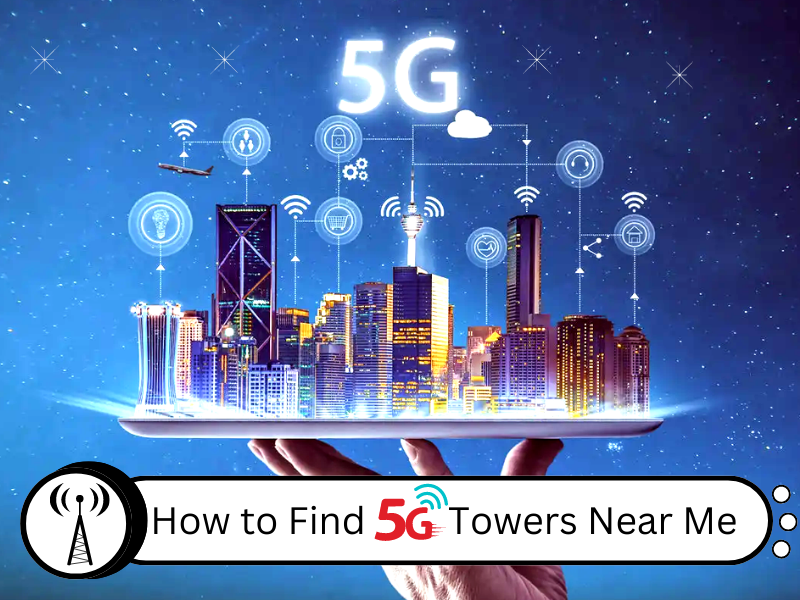5G is the latest jump in mobile technology, and 5G towers are currently being installed across the country in anticipation of its nationwide rollout. As a result of health concerns, I’ve had a few people ask how to locate 5G towers near me, so I’ve put together this article to cover your options.
Currently, there are 3 main ways to find 5G towers near you:
- Ookla 5G interactive map and towers locator
- Verizon 5G coverage map
- T-Mobile 5G coverage map
I’ll explain each of these in detail below, including step-by-step walkthroughs of how to check the information. Although the Ookla map should generally provide you with the necessary information, it can be worth checking on several maps to make sure you’re fully covered. Before we cover these in more depth, let’s first take a look at what 5G is and what are the related health concerns.
How to find 5G towers near you
As mentioned, there are 3 ways to find 5G towers near you. However, none of them are necessarily straightforward, and none of the go-to cellphone tower monitoring sites currently track 5G towers.

Instead, you’ll have to spend a bit of time playing about on these various sites. In order to make this process a bit easier for you, I’ve gone through the steps in detail below, providing screenshots of the websites so you’ll know exactly what to look for.
1. Ookla 5G Interactive Maps and Towers Locator
The first step in your 5G tower hunt should be the Ookla rollout map. I’d recommend starting with this one because it’ll tell you whether or not there are 5G towers near you in your area, and if there is, you can use one of the other maps for a more detailed look.
Ookla is a fairly good map that offers information for the whole planet. It’s updated every week, so be sure to check back on it another time if there’s currently no information for your area.

Limited availability is 5G towers that are in place but not registered on commercial networks, although this doesn’t mean they’re not in use. Finally, pre-release refers to towers that are being built or are in the final stages of rollout to the general market.
When searching for 5G towers in your area, it makes sense to have all 3 filters enabled, as you’re interested in the number of towers that exist. After all, pre-release towers will become commercially available at some point, and it won’t be long until they’re live.
Getting information on 5G in your neighborhood
After using the Ookla map to determine whether there are 5G towers near you in your area, you’ll next need to find out where the towers are located. To do this, you’ll need to switch over to a network-specific map, which is another reason why the Ookla map comes in handy.
The only issue with this, though, is that not all networks have detailed maps of their coverage. For example, AT&T currently has no information, although their coverage can be found on Cellular Maps. However, this information isn’t particularly relevant because it doesn’t tell you about the towers.
The low band towers function just like 4G towers and emit the same kind of radiation. While this isn’t necessarily safe, it’s less of a concern than the high band waves.
Below are methods to use the maps on the Verizon and T-Mobile websites. Verizon is already using high band towers, whereas T-Mobile still uses low band cellphone towers. As a result, we’ll get to see how to locate both.
2. Verizon 5G Coverage Map
After opening the Verizon coverage map, you’ll be given a list of cities in which 5G coverage is installed. If you don’t see your city on the list, it means Verizon doesn’t have any 5G towers near you in your area. Return to the Ookla map to confirm you’re looking at the correct network.

The key in the bottom left corner details what each color means. The red dots indicate a high band 5G towers near a city landmark, and areas in white partly receive 5G coverage.
However, it’s worth noting that the Verizon map only shows commercially available towers, so there might be some discrepancies between the information found here and the information displayed on the Ookla map.
3. T-Mobile 5G Coverage Map
Another option to try instead of the Verizon map is the T-Mobile map. This realistically does the same job but with a different network, so it can be worth checking both depending on what the Ookla map tells you.
However, a major advantage of this map over the others is that you can begin by putting in more detailed information about your location, such as your city, state, or ZIP code. This at least means you don’t need to manually search for your location.
Again, much like the Verizon map, this one only shows commercially available 5G coverage in your area. Monitor it regularly to see if this changes.
Some final thoughts
5G rollout has been on the rise in recent months as many companies push to provide the best nationwide coverage. While some are miles ahead of others, this arguably isn’t our biggest concern.
Regardless of the network provider, greater 5G coverage means more 5G towers. The ones to look out for are the high band towers, which are more prevalent in urban areas because of their function.
Realistically though, the only information that matters is whether your house is covered by 5G. If it is, or soon will be, then it can be worth taking some steps to reduce your exposure to this new kind of phone signal.



